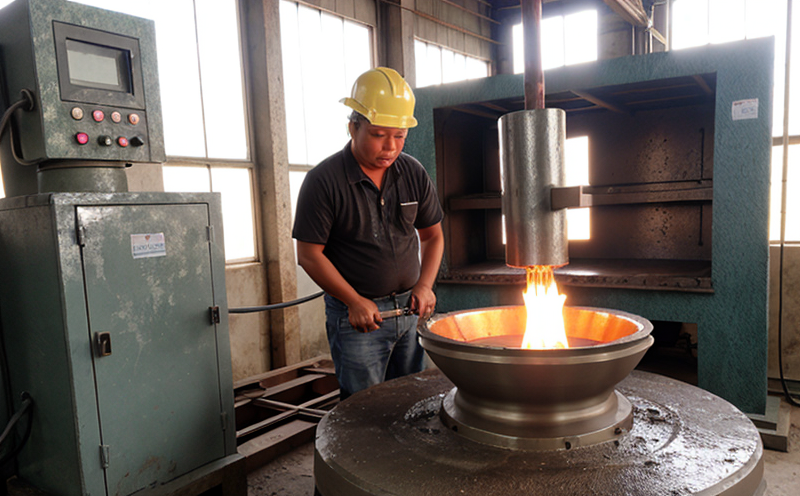ISO 4990 Steel Castings General Testing Requirements
The ISO 4990 standard outlines general testing requirements for steel castings. This international standard is crucial for ensuring that castings meet the necessary mechanical properties, dimensional tolerances, and surface integrity required in various industrial applications.
Steel castings are widely used across different sectors including automotive, aerospace, defense, and manufacturing due to their ability to produce complex shapes cost-effectively. However, ensuring consistent quality is paramount for reliability and safety. ISO 4990 provides a framework that helps manufacturers achieve this consistency by specifying the testing methods and acceptance criteria.
The standard applies to steel castings made from various alloys such as carbon steel, low-alloy steels, and stainless steels. It covers a range of tests including mechanical property tests (tensile strength, yield strength), hardness tests, non-destructive testing (NDT) methods like magnetic particle inspection and ultrasonic testing, and visual inspections.
One of the key aspects of ISO 4990 is its emphasis on pre-production and in-process control. This ensures that any issues are identified early in the production cycle rather than at the end when it's more costly to rectify. By adhering to these guidelines, manufacturers can improve product quality while reducing waste and rework.
Another important feature of ISO 4990 is its focus on traceability. Every step from raw material procurement through final inspection should be documented accurately so that any discrepancies can be traced back to their source. This not only aids in maintaining high standards but also facilitates compliance with regulatory requirements.
Given the complexity and importance of steel castings, it's essential for organizations involved in this sector to understand these testing requirements thoroughly. Compliance ensures better product performance which translates into safer operations across industries ranging from automotive manufacturing to heavy machinery construction.
The process outlined by ISO 4990 involves several stages starting with raw material inspection and proceeding through mold preparation, casting, heat treatment, machining, and finally inspection before shipment or installation.
- Raw Material Inspection
- Mold Preparation
- Casting Process
- Heat Treatment
- Machining Operations
- Final Inspection
Each stage has specific checks that must be performed to ensure adherence to the standards set forth in ISO 4990. These include dimensional checks, surface inspections, hardness testing, and mechanical property evaluations among others.
By following these stringent protocols throughout the entire production cycle, manufacturers can produce high-quality steel castings that meet both internal quality assurance goals as well as external regulatory requirements such as those imposed by relevant authorities like SAE International or ASME.
Applied Standards
The ISO 4990 standard aligns closely with other international standards in the field of metal casting. For instance, it complements ASTM A370 which deals specifically with mechanical testing methods for steel products and EN 1068 that focuses on cast iron castings.
Compliance with these standards is not only beneficial from a technical perspective but also helps companies maintain their reputation in global markets where adherence to international norms is increasingly becoming an expectation rather than just a compliance issue.
Furthermore, by following ISO 4990 and its associated standards, manufacturers can ensure that they are meeting the highest industry standards. This can be particularly advantageous when bidding on contracts or seeking certification from recognized bodies such as Lloyd's Register or DNV GL.
Industry Applications
- Aerospace: Ensuring critical components like engine casings and structural elements are free of defects is crucial for safety. ISO 4990 helps achieve this by providing robust testing methods.
- Automotive: From brake calipers to transmission housings, steel castings play vital roles in vehicle design. Adherence to these standards ensures that parts work reliably under demanding conditions.
- Construction Equipment: Heavy machinery used in construction requires durable components which can withstand harsh environments and heavy loads. ISO 4990 aids in producing such reliable parts.
- Offshore Oil & Gas: Pipeline segments, risers, and other equipment need to be robust against corrosion and mechanical stresses. The testing procedures prescribed by this standard help ensure these requirements are met.
In all these sectors, the reliability of steel castings is paramount. ISO 4990 plays a pivotal role in ensuring that each component meets stringent quality benchmarks throughout its lifecycle from manufacturing to end-use application.
Quality and Reliability Assurance
The implementation of ISO 4990 contributes significantly towards enhancing the overall quality and reliability assurance processes within industrial manufacturing operations. Here are some ways it achieves this:
- Early Detection of Defects: By incorporating rigorous testing protocols early in the production process, potential flaws can be identified before they become irreparable issues.
- Consistent Quality: The standardized procedures ensure that every casting produced meets predetermined specifications regardless of location or batch size.
- Enhanced Safety: Ensuring all parts meet strict mechanical property requirements reduces the risk of accidents and failures in end-use applications.
- Better Customer Satisfaction: Consistently high-quality products lead to satisfied customers who are more likely to choose your company for future projects.
- Competitive Advantage: Demonstrating adherence to international standards can set a business apart from competitors, making it more attractive to potential clients and partners.
Implementing ISO 4990 thus provides numerous benefits beyond mere compliance; it enhances operational efficiency, improves product quality, increases customer satisfaction, and ultimately strengthens the brand’s reputation in the marketplace.





